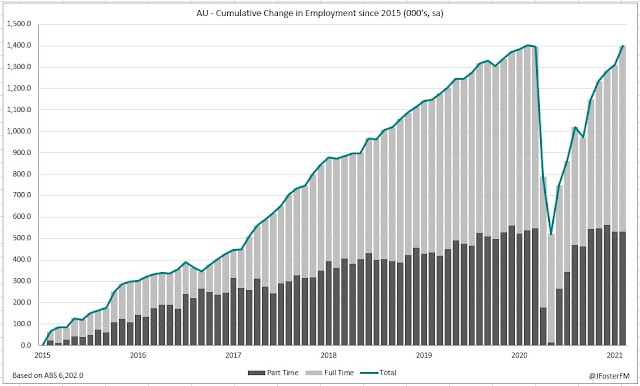Australia's latest report on labour market conditions for the month of March is due to be published by the ABS at 11:30am (AEST) this morning. Nine months after the reopening of the national economy, employment completed a v-shaped recovery to its pre-pandemic level after a much stronger-than-expected rise of 88.7k in February. Headline unemployment fell to its lowest level in the period, declining from 6.3% to 5.8% but remained well above its pre-pandemic rate of 5.2%. Today's report comes ahead of the withdrawal of the Federal Government's JobKeeper wage subsidy policy that maintained employer-employee connections and supported incomes through the earlier shutdowns.
As it stands | Labour Force SurveyEmployment posted its strongest outcome since the initial month of the reopening surging by 88.7k in February, printing well above the consensus estimate of 30.0k following on from a 29.5k rise in January. Full-time employment (89.1k) accounted for all of February's gain as the part-time segment declined slightly (-0.5k).
When Covid restrictions were first eased, part-time employment snapped back sharply to start the recovery, but more recently the full-time segment has taken up the running rising by 359.6k since October compared to a 67.9k rise in part-time employment. Overall, total employment is now back to its pre-pandemic level of around 13.1 million 9 months after the reopening. The level of full-time employment is a touch higher (0.2%) than prior to the pandemic, while part-time employment is slightly lower (-0.4%).
With the national participation rate remaining around a record high in February at 66.1%, the strong employment outcome was able to drive the unemployment rate down sharply from 6.3% to 5.8%. Unemployment peaked at 7.5% in July, though it remains elevated on its pre-pandemic level (5.2%) and is well above the low 4s range estimated by the RBA to be the level of full employment. Broader measures of spare capacity have improved significantly from their shutdown highs but rates of underemployment (8.5%) and underutilisation (14.4%) are much higher than would be the case in a tight labour market.
After a slow start to the year where a higher than usual number of workers were taking annual leave, hours worked rebounded from their 4.9% fall in January with a 6.1% rise in February. In contrast to employment, total hours worked remain lower (-0.7%) than their pre-pandemic level, pointing to the ongoing effects of activity restrictions and a higher level of spare capacity in the economy.
Market Expectations | Labour Force Survey
The median estimate is for employment to rise by 35.0k in March, with forecasts ranging up to 65.0k on the high side and 10.0k on the low side. National unemployment is anticipated to tick lower to 5.7% from 5.8%; the range of estimates is between 5.6% and 5.9%.
The median estimate is for employment to rise by 35.0k in March, with forecasts ranging up to 65.0k on the high side and 10.0k on the low side. National unemployment is anticipated to tick lower to 5.7% from 5.8%; the range of estimates is between 5.6% and 5.9%.
What to watch | Labour Force Survey
The key point to highlight is that the March survey will be the final snapshot of labour market conditions before the withdrawal of the JobKeeper policy and the coronavirus supplement payments. While this is not widely expected to materially derail the progress that has already been achieved, there will be some dislocation with Federal Treasury estimating the transitional effects could result in 100-150k job losses, though this would not necessarily amount to an equivalent rise in unemployment as that would depend on the activity of those affected workers in terms of their participation and ability to secure another job. There, the situation is encouraging with forward-looking indicators of labour demand, including job vacancies and components within the NAB Business Survey and PMIs at very elevated levels. Also, watch for the change in hours worked over Q1 as it will provide a good approximation of GDP growth prospects for the March quarter.




